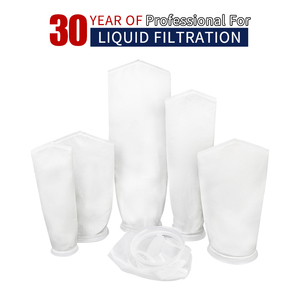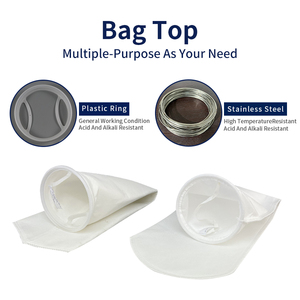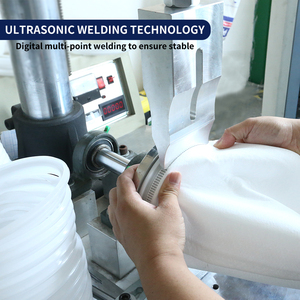(1260 products available)


























































































































































































































NMO filter bags are used to contain and capture particles in filtration systems. Several types of NMO filter bags are available on the market.
The following NMO filter bags specifications:
Material
NMO filter bags are made from nylon monofilament. Nylon material is known for its durability, kink resistance, elasticity, and longevity, which allows the filter bags to prolong their service lives. The monofilament design creates a thin, single strand mesh with precision-sized pores that allow smooth and efficient filtration.
Micron Sizes
NMO filter bags come in different micron sizes that are suitable for separating various particles and contaminants. The micron sizes range typically include 1, 5, 10, 20, 50, 100, 200, and 500 microns. A smaller micron size means more precise filtration and the ability to capture smaller particles.
Closure Types
NMO filter bags are available in different closure types to meet various filtration needs. Drawstring closures allow the bags to be easily secured around the filter top. Snap closures provide a more secure and rigid attachment method for industrial applications. Zipper closures make it easy to replace the filter media and access the bag interior. Other closures include velcro and pouch style.
Diameter/Size
NMO filter bags come in different diameters and sizes to fit various filter machines and equipment. The diameters are usually measured at the top of the filter bag and include 7'', 9'', 11'', 13'', 16'', 19'', 22'', and custom sizes. The lengths of the bags also vary according to applications. Common lengths include 24'', 32'', 36'', 48'', 60'', 72'', and custom lengths.
Proper maintenance of NMO filter bags plays a key role in ensuring their efficiency and increasing their service lives. Following are some maintenance tips for filter bags:
Regular cleaning:
By using a soft brush, gently clean the surface of the NMO filter bag to avoid clogging the bag's mesh openings. If users find stubborn dirt, they can soak the filter bag in a cleaning solution for a while and then thoroughly rinse it with water.
Avoid over-cleaning:
It's important to know that each NMO filter bag has a limited cleaning times according to its material and micron sizes. Over cleaning may cause damage and lowering the filtration accuracy. Users should keep track of the usage and determine when to replace the filter bag to maintain optimal performance.
Storage:
When not in use, store the NMO filter bags in a clean, dry place away from direct sunlight. This can effectively avoid the risk of bag contamination and damage.
The NMO filter bags are used in various industries, including manufacturing, food and beverage, pharmaceutical, chemical, mining, fire protection, and wastewater treatment industries.
Evaluate filtration needs
Consider the specific filtration needs of the NMO filter press being used, including the desired particle size and the type of material being filtered.
Choose the right material
Selecting the appropriate textile filter bag material is crucial for achieving the desired filtration results and maintaining the integrity of the filtering process.
For example, polypropylene (PP) filter bags are widely used for general-purpose filtration, while nylon bags may be preferred for applications that require higher chemical resistance or durability.
Opt for the appropriate micron size
Selecting the right filter micron size is essential to achieve the desired level of filtration.
Coarse filter bags, such as 100, 200, and 400 micron, allow smaller particles to pass through, while fine filter bags, such as 10, 25, 50, 75, and 100 micron, capture more particles, leaving clearer filtrate.
Consider filter bag shape
Choose the filter bag shape that best fits the design of the NMO filter press and ensures effective filtration and separation.
With different shapes, such as round, oval, cylindrical, etc., the performance and efficiency of filtration may vary.
Pay attention to bag construction
Consider the filter bag construction, including the seam type and welding methods used, as these factors can affect the bag's performance and longevity.
Q1: Are NMO filter bags expensive?
A1: NMO filter bags are more expensive than the typical filter bags because of their high-quality materials and precise construction. However, their efficiency and ability to extend the life of valuable products make them a worthwhile investment.
Q2: What is the difference between NMO and NML filter bags?
A2: NML is a snap filter bag design that provides more snap filter area than NMO filter bags. NML filter bags are typically used in the middle of a filter press plate. NMO bags are often used at the front and rear of a filter press.
Q3: How often should users replace their NMO filter bags?
A3: In this case, it is always better to be late than early. If the NMO filter bags are still removing solid contaminants from the liquid being processed, there is no need to change them. However, they will eventually become clogged. When this happens, the reverse pulse jet cleaning will not be effective, and it will be time to change the NMO filter bags.
Q4: Can NMO filter bags affect the smell of coffee?
A4: Some people might have a filter-bag odour that affects the taste of the coffee. This could happen even before the first cup. New NMO filter bags may have a slight odour that users may notice when unpacking them. This odour will dissipate before brewing the first pot. If it is a concern, store the unused bags in an airtight container.